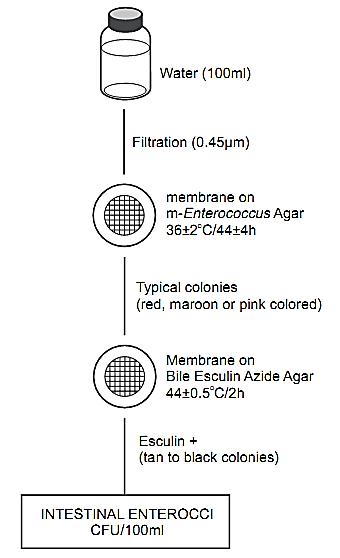


 النبات
النبات
 الحيوان
الحيوان
 الأحياء المجهرية
الأحياء المجهرية
 علم الأمراض
علم الأمراض
 التقانة الإحيائية
التقانة الإحيائية
 التقنية الحيوية المكروبية
التقنية الحيوية المكروبية
 التقنية الحياتية النانوية
التقنية الحياتية النانوية
 علم الأجنة
علم الأجنة
 الأحياء الجزيئي
الأحياء الجزيئي
 علم وظائف الأعضاء
علم وظائف الأعضاء
 الغدد
الغدد
 المضادات الحيوية
المضادات الحيوية| Membrane filtration method ISO 7899-2:2000 for intestinal enterococci in water |
|
|
|
Read More
Date: 17-3-2016
Date: 3-3-2016
Date: 2025-02-16
|
Membrane filtration method ISO 7899-2:2000 for intestinal enterococci in water
This method of the International Organization for Standardization is applicable to the detection and enumeration of intestinal enterococci (Lancefield Group D enterococci and fecal streptococci) in water, especially drinking water, water from swimming pools, and other disinfected clean waters. The method can be applied to other types of water, except when suspended matter or many interfering microorganisms are present. It is particularly suitable for the examination of large volumes of water containing only a few intestinal enterococci.
1- Material required for analysis
• Membrane filtration system
• Sterile membrane filters 0.45 μm pore size
• m-Enterococcus Agar (also called Slanetz & Bartley Medium)
• Bile Aesculin Azide Agar
• Laboratory incubator set to 36 ± 2°C
• Laboratory incubator set to 44 ± 0.5°C
2 - Procedure
A general flowchart for the enumeration of intestinal enterococci in water using the membrane filtration method ISO 7899-2:2000 is shown in Figure 1.
a) Preparation of the sample and filtration: filter a suitable volume of the water sample through a sterile membrane filter of 0.45 μm pore size. The volume depends on the type of sample. For drinking water or bottled water 100 ml is the volume commonly used.
b) Incubation and colony counting: Transfer the membrane to a plate of m-Enterococcus Agar (also called Slanetz & Bartley Medium). Incubate plates at 36 ± 2°C/44 ± 4 h. Count all colonies which show a red, maroon or pink color (either in the center or throughout the colony) as presumptive intestinal enterococci.
c) Confirmation: If there are typical colonies, transfer the membrane onto a plate of Bile Esculin Azide Agar (without inverting). Incubate plates at 44 ± 0.5°C/2 h and read immediately. Consider as intestinal enterococci all typical colonies showing a tan to black color in the surrounding medium (esculin hydrolysis).
Note c.1) On crowded plates the differentiation of positive colonies may be difficult due to the diffusion of the color to adjacent colonies.
d) Calculation of the result: The number of intestinal enterococci colony forming units (CFU)/volume filtered is the number of tan to black colonies counted on the membrane.

Figure 1 Scheme of analysis for the enumeration of intestinal enterococci in water using the membrane filtration method ISO 7899-2:2000.
References
Silva, N.D .; Taniwaki, M.H. ; Junqueira, V.C.A.; Silveira, N.F.A. , Nasdcimento , M.D.D. and Gomes ,R.A.R .(2013) . Microbiological examination methods of food and water a laboratory Manual. Institute of Food Technology – ITAL, Campinas, SP, Brazil .



|
|
|
|
التوتر والسرطان.. علماء يحذرون من "صلة خطيرة"
|
|
|
|
|
|
|
مرآة السيارة: مدى دقة عكسها للصورة الصحيحة
|
|
|
|
|
|
|
نحو شراكة وطنية متكاملة.. الأمين العام للعتبة الحسينية يبحث مع وكيل وزارة الخارجية آفاق التعاون المؤسسي
|
|
|